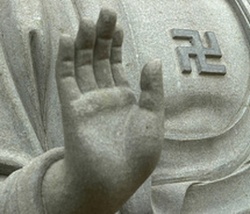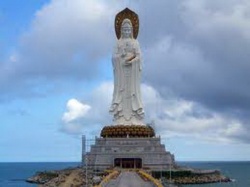Difference between revisions of "List of bodhisattvas"
| Line 1: | Line 1: | ||
[[File:28zjvcc.jpg|thumb|250px|]] | [[File:28zjvcc.jpg|thumb|250px|]] | ||
| − | '''Akasagarbha''' | + | '''[[Akasagarbha]]''' |
| − | (Ch. 虛空藏 , Xu Kong Zang, Kr. Huh Gong Zang, Jp. Kokuzo) - The Bodhisattva of infinite happiness generated by helping countless numbers of sentient beings. | + | (Ch. 虛空藏 , Xu Kong Zang, Kr. Huh Gong Zang, Jp. [[Kokuzo]]) - The [[Bodhisattva]] of [[infinite]] [[happiness]] generated by helping countless numbers of [[sentient beings]]. |
| − | '''Avalokitesvara''' | + | '''[[Avalokitesvara]]''' |
| − | (Ch. | + | (Ch. [[觀音]] , [[Guan Yin]], Kr. Guan Um, Jp. [[Kannon]], Tib. [[Chenrezig]], Viet. Quán Thế Âm) - The [[bodhisattva]] of [[compassion]], the listener of the world's cries who uses [[skillful means]] to come to their aid; the most universally [[acknowledged]] [[Bodhisattva]] in [[Mahayana Buddhism]]. Known as [[Guan Yin]] in {{Wiki|East Asia}}, [[Chenrezig]] in [[Tibet]], and Migjid Janraisig in [[Mongolia]]. |
| − | '''Baba Saheb''' | + | '''[[Baba]] Saheb''' |
| − | Param Pujya Dr. Bhimrao Ramji Ambedkar is regarded as a Bodhisattva by Indian Buddhist Bhikkus and by millions of other Buddhists. | + | Param Pujya Dr. Bhimrao Ramji Ambedkar is regarded as a [[Bodhisattva]] by [[Indian]] [[Buddhist]] [[Bhikkus]] and by millions of other [[Buddhists]]. |
| − | '''Ksitigarbha''' | + | '''[[Ksitigarbha]]''' |
| − | (Ch. 地藏 , Di Zang, Kr. Ji Zang, Jp. Jizo, Tib. Sai Nyingpo, Viet. 'Địa Tạng). The bodhisattva of the beings suffering in hellish realms, or the bodhisattva of great vows. | + | (Ch. 地藏 , Di Zang, Kr. Ji Zang, Jp. [[Jizo]], Tib. Sai Nyingpo, Viet. 'Địa Tạng). The [[bodhisattva]] of the [[beings]] [[suffering]] in hellish [[realms]], or the [[bodhisattva]] of great [[vows]]. |
| − | '''Mahasthamaprapta''' | + | '''[[Mahasthamaprapta]]''' |
| − | (Ch. 大勢至, Da Shì Zhì, Kr. Dae Sae Zhi, Jp. Seishi, Viet. Đại Thế Chí) - Represents the power of wisdom, seen on the left of Amitabha in Pure Land Buddhism. | + | (Ch. 大勢至, Da Shì Zhì, Kr. Dae Sae Zhi, Jp. [[Seishi]], Viet. Đại Thế Chí) - Represents the [[power]] of [[wisdom]], seen on the left of [[Amitabha]] in [[Pure Land Buddhism]]. |
| − | '''Maitreya''' | + | '''[[Maitreya]]''' |
| − | (Ch. | + | (Ch. [[彌勒]] , Mi Le, Kr. Mi Ruk, Jp. [[Miroku]], Viet. Di Lạc) - The [[bodhisattva]] to be [[reborn]] and to become [[enlightened]], [[thus]] succeeding [[Gautama Buddha]] in the future. Known for his benevolence. |
| − | '''Manjusri''' | + | '''[[Manjusri]]''' |
[[File:3532ges.jpg|thumb|250px|]] | [[File:3532ges.jpg|thumb|250px|]] | ||
| − | (Ch. 文殊 , Wen Shu, Kr. Moon Soo, Jp. Monju, Tib. Jampal Yang, Viet. Văn Thù) - Bodhisattva of keen awareness and wisdom. | + | (Ch. 文殊 , Wen Shu, Kr. [[Moon]] Soo, Jp. [[Monju]], Tib. Jampal [[Yang]], Viet. Văn Thù) - [[Bodhisattva]] of keen [[awareness]] and [[wisdom]]. |
| − | '''Nagarjuna''' | + | '''[[Nagarjuna]]''' |
| − | (Ch. 龍樹, Long Shu, Viet. Long Thọ) - The founder of the Madhyamaka (Middle Path) school of Mahāyāna Buddhism. | + | (Ch. 龍樹, Long Shu, Viet. Long Thọ) - The founder of the [[Madhyamaka]] ([[Middle Path]]) school of [[Mahāyāna Buddhism]]. |
| − | '''Niō''' | + | '''[[Niō]]''' |
| − | Two wrath-filled and muscular guardians of the Buddha, standing today at the entrance of many Buddhist temples in Japan and Korea under the appearance of frightening wrestler-like statues. They are manifestations of the Bodhisattva Vajrapani. | + | Two wrath-filled and muscular guardians of the [[Buddha]], standing today at the entrance of many [[Buddhist]] [[temples]] in [[Japan]] and [[Korea]] under the appearance of frightening wrestler-like [[statues]]. They are [[manifestations]] of the [[Bodhisattva]] [[Vajrapani]]. |
| − | '''Padmasambhava''' | + | '''[[Padmasambhava]]''' |
| − | (Ch. 蓮華生上師, Lianhuasheng Shang Shi, Tib. Padma Jungne or Guru Rinpoche) - Most associated with Tibetan Buddhism and Bhutanese Buddhism. The Nyingma school regards Padmasambhava as a second Buddha. | + | (Ch. 蓮華生上師, Lianhuasheng Shang Shi, Tib. [[Padma]] Jungne or [[Guru Rinpoche]]) - Most associated with [[Tibetan Buddhism]] and {{Wiki|Bhutanese}} [[Buddhism]]. The [[Nyingma school]] regards [[Padmasambhava]] as a second [[Buddha]]. |
| − | '''Samantabhadra''' | + | '''[[Samantabhadra]]''' |
| − | (Ch. 普賢 , Pu Xian, Kr. Bo Hyun, Jp. Fugen, Tib. Kuntu Zangpo, Viet. Phổ Hiền) - Represents the practice and meditation of all Buddhas. | + | (Ch. 普賢 , Pu Xian, Kr. [[Bo]] Hyun, Jp. [[Fugen]], Tib. Kuntu Zangpo, Viet. Phổ Hiền) - Represents the practice and [[meditation]] of all [[Buddhas]]. |
'''Sangharama''' | '''Sangharama''' | ||
| − | (Ch. 伽藍, Qie Lan, Viet. Già Lam) - Only revered in Chinese Buddhism-Taoism, Sangharama refer to a group of devas who guard Buddhist monasteries and the faith, but the title is usually referring to the legendary Chinese military general Guan Yu, who became a Dharmapala through becoming a Buddhist and making vows. | + | (Ch. 伽藍, Qie Lan, Viet. Già Lam) - Only revered in {{Wiki|Chinese}} Buddhism-Taoism, Sangharama refer to a group of [[devas]] who guard [[Buddhist]] [[monasteries]] and the [[faith]], but the title is usually referring to the legendary {{Wiki|Chinese}} military general [[Guan Yu]], who became a [[Dharmapala]] through [[becoming]] a [[Buddhist]] and making [[vows]]. |
| − | '''Shantideva''' | + | '''[[Shantideva]]''' |
[[File:6267626.jpg|thumb|250px|]] | [[File:6267626.jpg|thumb|250px|]] | ||
| − | 8th century scholar, wrote about Bodhisattvas. | + | 8th century [[scholar]], wrote about [[Bodhisattvas]]. |
| − | '''Sitatapatra''' | + | '''[[Sitatapatra]]''' |
| − | The goddess of the White Parasol and protector against supernatural danger. | + | The [[goddess]] of the White [[Parasol]] and protector against [[supernatural]] [[danger]]. |
| − | '''Skanda''' | + | '''[[Skanda]]''' |
| − | (Ch. 韋馱, Wei Tuo) - A Dharmapala who guards the Dharma, with links to Vajrapani and is somewhat the direct forbear to Murugan, a Hindu deity. Primarily worshipped in Chinese Buddhism. | + | (Ch. 韋馱, [[Wei Tuo]]) - A [[Dharmapala]] who guards the [[Dharma]], with links to [[Vajrapani]] and is somewhat the [[direct]] forbear to Murugan, a [[Hindu]] [[deity]]. Primarily worshipped in [[Chinese Buddhism]]. |
| − | '''Supushpachandra''' | + | '''[[Supushpachandra]]''' |
| − | Mentioned in Shantideva's A Guide to the Bodhisattva's Way Of Life | + | Mentioned in Shantideva's A Guide to the [[Bodhisattva's]] Way Of [[Life]] |
'''Suryavairocana''' | '''Suryavairocana''' | ||
| − | (Ch: 日光, Ri Guang, Kr. Il Guang, Jp: Nikkō) - One of two attendants of Bhaisajyaguru Buddha. | + | (Ch: 日光, Ri Guang, Kr. Il Guang, Jp: [[Nikkō]]) - One of two attendants of [[Bhaisajyaguru Buddha]]. |
| − | '''Tara''' | + | '''[[Tara]]''' |
| − | (Ch. 度母, Du Mu) - Female bodhisattva, or set of bodhisattvas, in Tibetan Buddhism. She represents the virtues of success in work and achievements. Also a manifestation of Avalokitesvara. | + | (Ch. 度母, Du Mu) - {{Wiki|Female}} [[bodhisattva]], or set of [[bodhisattvas]], in [[Tibetan Buddhism]]. She represents the [[virtues]] of success in work and achievements. Also a [[manifestation]] of [[Avalokitesvara]]. |
| − | '''Vajrapani''' | + | '''[[Vajrapani]]''' |
| − | (Ch. 金剛手, Jin Gang Shou, Kr. Kum Kang Soo, Jp.Shukongojin, Tib. Channa Dorje) - An early bodhisattva in Mahayana. | + | (Ch. 金剛手, Jin Gang Shou, Kr. Kum Kang Soo, Jp.Shukongojin, Tib. [[Channa]] [[Dorje]]) - An early [[bodhisattva]] in [[Mahayana]]. |
| − | '''Vasudhara''' | + | '''[[Vasudhara]]''' |
| − | Bodhisattva of abundance and fertility. Popular in Nepal. | + | [[Bodhisattva]] of abundance and {{Wiki|fertility}}. Popular in [[Nepal]]. |
Revision as of 23:29, 5 September 2013
(Ch. 虛空藏 , Xu Kong Zang, Kr. Huh Gong Zang, Jp. Kokuzo) - The Bodhisattva of infinite happiness generated by helping countless numbers of sentient beings.
(Ch. 觀音 , Guan Yin, Kr. Guan Um, Jp. Kannon, Tib. Chenrezig, Viet. Quán Thế Âm) - The bodhisattva of compassion, the listener of the world's cries who uses skillful means to come to their aid; the most universally acknowledged Bodhisattva in Mahayana Buddhism. Known as Guan Yin in East Asia, Chenrezig in Tibet, and Migjid Janraisig in Mongolia.
Baba Saheb
Param Pujya Dr. Bhimrao Ramji Ambedkar is regarded as a Bodhisattva by Indian Buddhist Bhikkus and by millions of other Buddhists.
(Ch. 地藏 , Di Zang, Kr. Ji Zang, Jp. Jizo, Tib. Sai Nyingpo, Viet. 'Địa Tạng). The bodhisattva of the beings suffering in hellish realms, or the bodhisattva of great vows.
(Ch. 大勢至, Da Shì Zhì, Kr. Dae Sae Zhi, Jp. Seishi, Viet. Đại Thế Chí) - Represents the power of wisdom, seen on the left of Amitabha in Pure Land Buddhism.
(Ch. 彌勒 , Mi Le, Kr. Mi Ruk, Jp. Miroku, Viet. Di Lạc) - The bodhisattva to be reborn and to become enlightened, thus succeeding Gautama Buddha in the future. Known for his benevolence.
(Ch. 文殊 , Wen Shu, Kr. Moon Soo, Jp. Monju, Tib. Jampal Yang, Viet. Văn Thù) - Bodhisattva of keen awareness and wisdom.
(Ch. 龍樹, Long Shu, Viet. Long Thọ) - The founder of the Madhyamaka (Middle Path) school of Mahāyāna Buddhism.
Two wrath-filled and muscular guardians of the Buddha, standing today at the entrance of many Buddhist temples in Japan and Korea under the appearance of frightening wrestler-like statues. They are manifestations of the Bodhisattva Vajrapani.
(Ch. 蓮華生上師, Lianhuasheng Shang Shi, Tib. Padma Jungne or Guru Rinpoche) - Most associated with Tibetan Buddhism and Bhutanese Buddhism. The Nyingma school regards Padmasambhava as a second Buddha.
(Ch. 普賢 , Pu Xian, Kr. Bo Hyun, Jp. Fugen, Tib. Kuntu Zangpo, Viet. Phổ Hiền) - Represents the practice and meditation of all Buddhas.
Sangharama
(Ch. 伽藍, Qie Lan, Viet. Già Lam) - Only revered in Chinese Buddhism-Taoism, Sangharama refer to a group of devas who guard Buddhist monasteries and the faith, but the title is usually referring to the legendary Chinese military general Guan Yu, who became a Dharmapala through becoming a Buddhist and making vows.
8th century scholar, wrote about Bodhisattvas.
The goddess of the White Parasol and protector against supernatural danger.
(Ch. 韋馱, Wei Tuo) - A Dharmapala who guards the Dharma, with links to Vajrapani and is somewhat the direct forbear to Murugan, a Hindu deity. Primarily worshipped in Chinese Buddhism.
Mentioned in Shantideva's A Guide to the Bodhisattva's Way Of Life
Suryavairocana
(Ch: 日光, Ri Guang, Kr. Il Guang, Jp: Nikkō) - One of two attendants of Bhaisajyaguru Buddha.
(Ch. 度母, Du Mu) - Female bodhisattva, or set of bodhisattvas, in Tibetan Buddhism. She represents the virtues of success in work and achievements. Also a manifestation of Avalokitesvara.
(Ch. 金剛手, Jin Gang Shou, Kr. Kum Kang Soo, Jp.Shukongojin, Tib. Channa Dorje) - An early bodhisattva in Mahayana.
Bodhisattva of abundance and fertility. Popular in Nepal.


